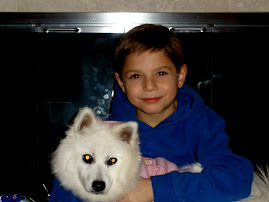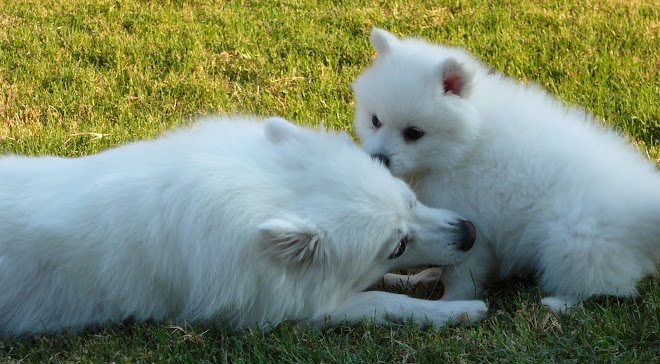
Since our puppies have started going to their new forever homes, I knew this would be a good time to continue with our Teaching Basic Commands series. The Japanese Spitz is very intelligent and can begin learning basic commands at around 9 weeks of age. However, you should ALWAYS remember to use the positive-reinforcement method. Also, when teaching puppies this young, remember to keep your sessions short and always remember to end on a positive note. If teaching a young puppy, be sure to start this series at the beginning (Entry #1) and work your way through this series in order. Let your puppy master the easier commands before moving on to the more difficult ones.
Teaching your dog to lie down using the "Down" command can help you prevent unwanted behaviors. "Down" combined with "Stay" can help you control your dog when company comes over. Your dog will not be able to jump on your guests. This command will also help your dog relax when he/she is overly excited.
To teach the "Down" command, you will begin by using the same lure as with "Sit".
- Start with your dog in the "Sit" position.
- Hold a treat between your thumb and your forefinger. The other fingers should be outstretched with your palm facing the floor.
- Keeping the treat close to your dog's nose, slowly lower your hand to the floor. Your dog's head should follow your hand.
- Move your hand around the outside of your dog's body toward his rear end - this will cause his/her head to follow your hand around, resulting in his/her body sliding into a down position.
- Reward the behavior by giving your dog the treat.
For some dogs, "Down" can be much more difficult to learn than the "Sit" command. For these dogs, it may be a good idea to break up teaching this command into smaller steps. If your dog doesn't lie down, you can do what is called shaping the behavior. This means mastering one portion of the behavior at a time.
- Follow the first three steps detailed above.
- Reward the behavior when your dog lowers his/her head.
- Once your dog is consistently lowering his/her head, stop rewarding that behavior.
- Now, lure his/her head around the side of his body and mark that behavior.
- Continue along these lines until your dog is completely in a down position.
Note that you may have to break the steps down even smaller.
The most important thing is to remember to BE PATIENT and don't get frustrated. Your dog can feel your frustration and this is counter-productive. If you are patient and continue to follow these steps, your dog will soon master the "Down" position.












